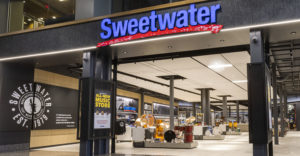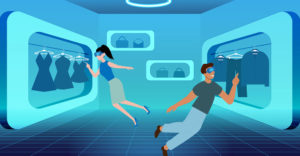
At Salesforce.com’s Dreamforce 2010 conference this week, EDL Consulting showed off version 2.0 of CloudCraze, which it touts as the first e-commerce platform built natively on Force.com.
CloudCraze is claimed to provide the functionality of more expensive enterprise multi-channel commerce packages at a fraction of the price, and its implementation takes one-quarter the time traditional commerce software does.
CRM Buyer sat down with EDL Founder, President and CEO Bill Loumpouridis to discuss CloudCraze at Dreamforce Tuesday.
CRM Buyer: EDL Consulting has been a third-party software implementer for a while. Was it implementing B2B software?
Bill Loumpouridis:
Primarily for Sterling Commerce — its legacy Comergent product, which in the early part of the last decade was the highest-ranked B2B e-commerce software. It did things like data storage systems and telephony systems, which require very complex installations in the B2B world.
We were a small company back then, a 20-person shop out of Chicago, and here we were, getting in front of very large customers for Sterling Commerce — companies like Hitachi Data Systems, Pitney Bowes.
We’d been through the dot-com bust, and during the dot-com boom, one of the myths was the concept that the Internet was about disintermediation. This is the notion that everything was going to go direct and you’d cut out the middleman. What no one realized was that the channel was a very important part of the ecosystem and served a very valuable function.
So in 2003, 2004 we were putting out things that empowered the channel. We took the whole notion of disintermediation and inverted it. That’s how we got our start in e-commerce.
What we were doing back then was taking a holistic approach to e-commerce. We were looking at the whole inquiry-to-cash process, and that’s how we got involved with Salesforce. Very often, our clients had Salesforce.com in-house, and they wanted seamless linkage between inquiry and action and fulfillment through the ERP system.
So we developed very specialized expertise in taking CRM and ERP and making that a seamless experience, and that informed our point of view on this future state, this nirvana future of a single view. Everybody in the CRM world talks about a 360 degree view of the customer, but that’s very difficult to do when you’ve got siloed systems.
CRM: Yes, there was this debate going on in the ’90s about exactly who a company’s customer was. Was it the person at the client who placed the order for, say, 20 PCs? Or was it the guy at the client’s receiving dock who signed for the delivery? Or was it the heads of the departments to which the PCs went?
Loumpouridis:
Customer data is often fragmented across ERP, CRM and e-commerce silos, and you have to reconcile them. You’re going to have numerous copies of data and numerous systems that have access to that data.
When we built CloudCraze, which is the first and only enterprise-class e-commerce product that’s native on Force.com, we had the vision. We’d been doing this stuff in the Java world, it’s really hard, takes a really long time and is really expensive. We couldn’t even have a conversation with a potential customer if they weren’t willing to spend a million dollars in services.
For the first three months, all we did was data model, because we knew if we didn’t do the data model right, we’d spend the rest of our lives writing patches for a crappy data model. Once the data model was right, we started layering in code.
CRM: A million dollars just to start?
Loumpouridis:
Enterprise e-commerce is hard. Talk to any enterprise customer. They spend easily over a million dollars on e-commerce and as much on licenses.
So we’d been doing Java work for the greater part of the decade, then Force.com got announced at Dreamforce in 2008, then later it announced Sites, which lets you take your Force.com work and expose it as a website. That’s when we realized we could take all this domain expertise, everything we were doing in the Java world that’s very expensive, and move it to this brand-new world that’s better, faster, cheaper, hyperscale; build a product and bring it to market.
So we’ve now got this product that takes the holistic approach to e-commerce and CRM. It uses the same data, the same platform, there are no integration headaches.
CRM: How do you access information and cut across the silos?
Loumpouridis:
As a CloudCraze client, you need to have the courage to make the tough decisions. If you want to take advantage of this disruptive play, you have to make tough choices.
There’s a reason why things are siloed — because people make the easy decisions. It’s easy to set up a silo. It’s not scalable and not hard to maintain, and you don’t ruffle any feathers.
When we get into our storyboarding, we talk about a system of record for customer data. We want to know what system owns the true master data. What are the rules of governance as to who can change that data?
CRM: How does CloudCraze get that 360 view after a customer bites the bullet and makes the hard decisions?
Loumpouridis:
You have these customer objects on Salesforce. I don’t need to do a SOA (service oriented architecture) transaction to get back and keep customer information current; it’s all part of the Salesforce objects.
When you talk about going across silos and having a holistic view, you first think of a system that’s capable of storing and accessing all that silo data. Sales support, front office, marketing and commerce — those are the front office, and they’re the silos we address.
The same things we used to do for $1 million … we’re now doing for a couple of hundred thousand dollars, and doing them in six months, not two years.
Oracle bought ATG for about $1 billion, and if you read the press release about the deal, they talk about a multichannel CRM and e-commerce solution, and that’s where they want to go. We’re already there. We already have that seamless single-platform view of CRM and e-commerce. It’s unique.
We were talking about this 10 years ago, and it took 10 years to become a reality but it’s here. In the last six months, we brought up four customers. These are mid-market companies and they have multimillion-dollar equivalent systems that they’ve purchased for $200,000. For the first time, they can compete on the same playing field with their larger competitors.




















































